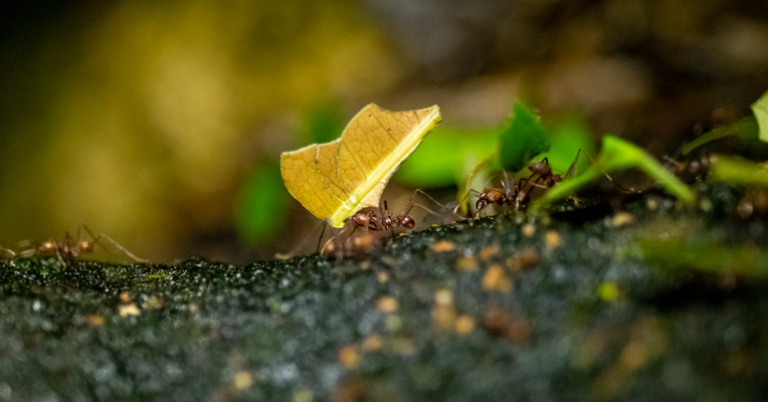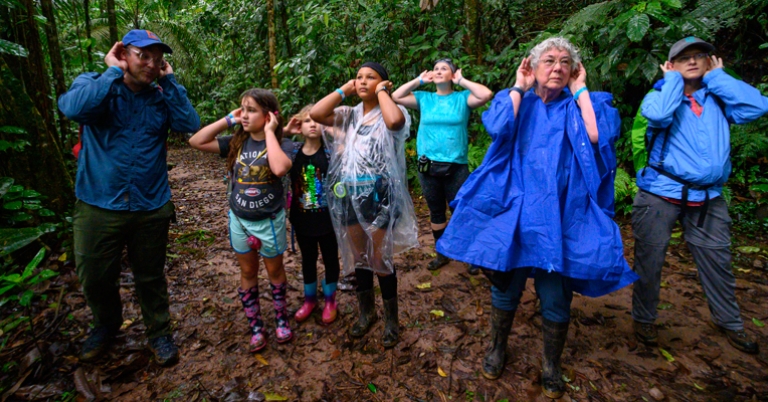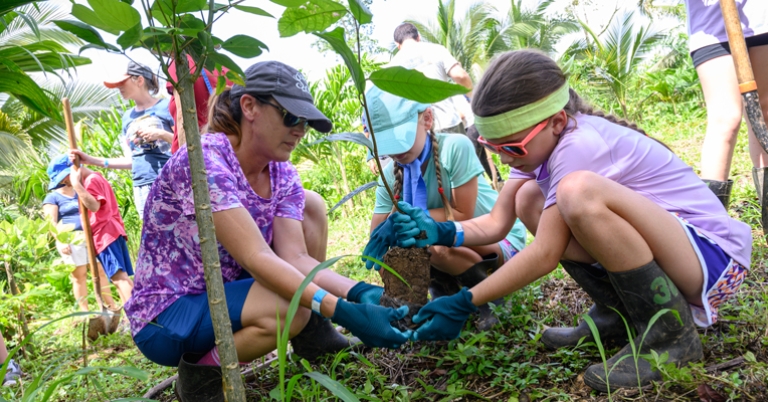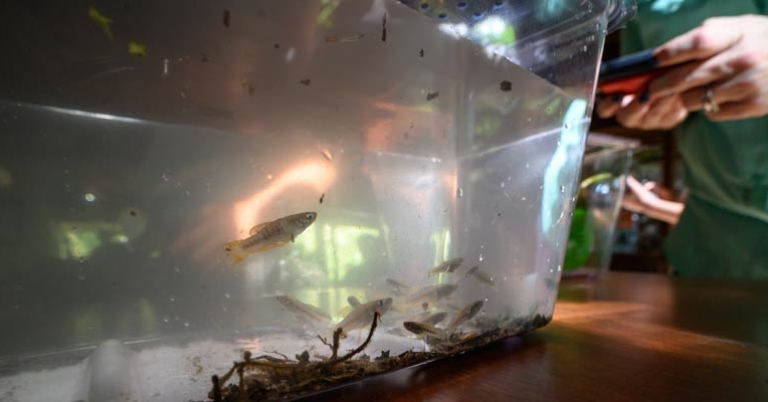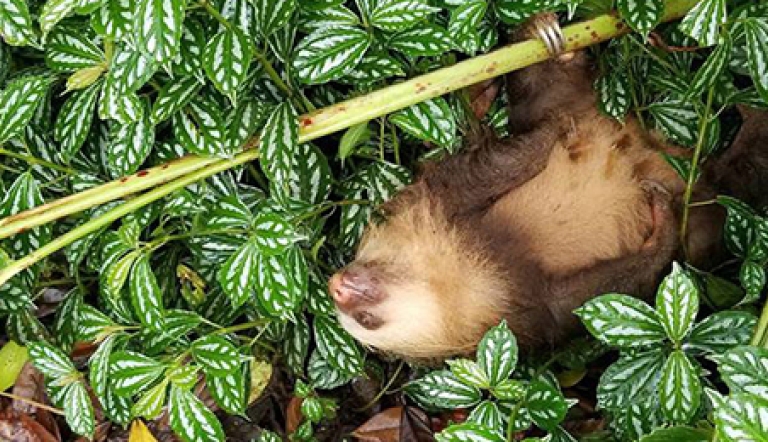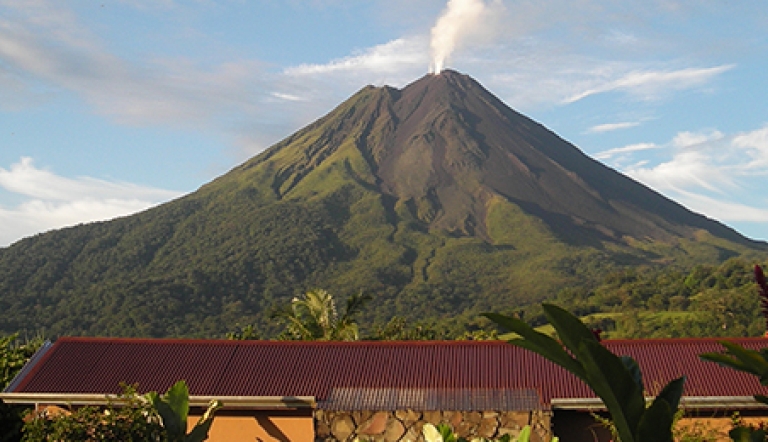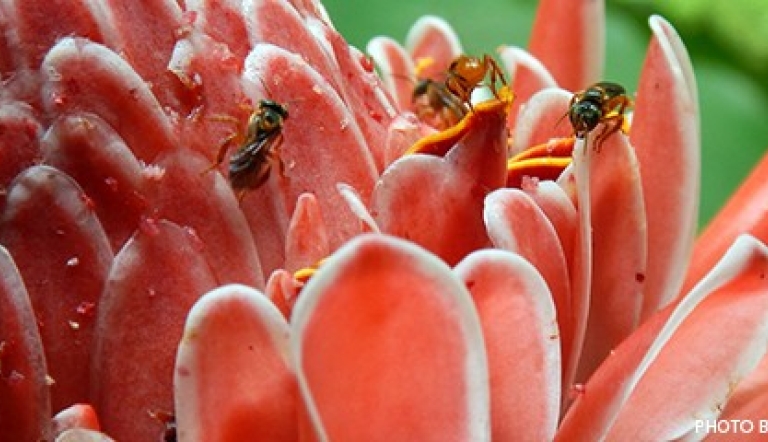Costa Rica | Family Rainforest Camp
About this trip
The Florida Museum of Natural History invites you and your family to join them at Selva Verde Rainforest Reserve in Costa Rica. Explore fascinating wildlife and forest ecosystems, be immersed in the adventure of a living classroom, and participate in a hands-on, once-in-a-lifetime experience with Museum scientists.
This enriching program is for families with children ages 5-17. Minors should be accompanied by at least one parent or guardian. Participants will be divided into appropriate age groups for activities and workshops.
Workshops conducted by Museum staff include:
- Tools of the Trade: Hands-On Learning: Learn how to use your senses, microscopes and gadgets for finding, collecting and observing in the field.
- Exploration Bird Hikes: Use your ears to listen for birds and then spot them using a scope.
- Forest, Trees & Plants: Activities focus on sustainable growth and reforestation and include planting native trees.
- Wonderful Water Bioblitz: Take a closer look at the fish, aquatic invertebrates, and aquatic plants collected while dip netting. Use field tools, microscopes, and small water tanks for a closer look at hard-to-see organisms.
Highlights
- Discover rainforest ecology on guided hikes through Selva Verde Reserve’s rainforest.
- Learn about the importance of biological corridors and conservation.
- Participate in a reforestation project by planting native trees on local farms to help strengthen the Mesoamerican Biological Corridor.
- Meet children from a local community and learn about their daily life and culture while playing games together.
- Go birding with local ornithologists to search for macaws, toucans, and other tropical birds.
OPTIONAL EXTENSION: Continue your Costa Rica experience with a post-trip extension, July 6-9. See where the Museum’s butterfly pupae are raised at El Bosque Nuevo in Guanacaste, and observe bioluminescence at Playa Rajada.
PLEASE NOTE: As safety and security are our highest priority, we have adopted extensive protocols to address COVID-19. Our field leaders are vaccinated and we require our travelers to be vaccinated. We follow strict field hygiene practices which are outlined on our website. If required, we arrange for Covid testing at the end of your program.
Reserve Risk-free - Registrations made for travel departing between now and December 31, 2022 are fully refundable with no cancellation penalties until the final payment deadline (95 days before departure). We strongly recommend purchasing travel protection.
Meet your leaders
 Dave Blackburn
Dave Blackburn
Dave Blackburn is the Curator of Herpetology in the Florida Museum of Natural History. In his role at the Florida Museum, Dave oversees research and curation of the museum’s scientific collection of amphibians and reptiles, which is among the top 10 of such collections in the US and the largest in the southeastern US. After completing college at the University of Chicago, he did his PhD at Harvard University, followed by three years as a postdoctoral researcher at the University of Kansas and then four years as a curator at the California Academy of Sciences. The research by Dave and his students focuses on the diversity, evolution, and conservation of amphibians and reptiles. To date, he has described 27 new species of frogs from Africa, South America, and Asia. Dave's work has been featured in the New York Times, National Geographic, the magazine Science, the children’s book “When Lunch Fights Back” by Rebecca Johnson, and Christopher Kemp’s recent book “The Lost Species.”
 Lucas C. Majure
Lucas C. Majure
Lucas C. Majure is Curator of the University of Florida Herbarium at the Florida Museum of Natural History. He is a plant systematist, interested in understanding the diversity of green plants on the planet and actively works to describe that diversity, especially in the Americas. Majure is especially interested in the cactus family (Cactaceae), as well as other diverse, Neotropical plant families in both humid and dry forests of the Caribbean, one of the focal areas of his research. He earned his Ph.D. at the University of Florida in 2012 and came back to work as a professor/researcher/curator in the museum in Fall 2018.
Support research and education at the Florida Museum! A portion of your fees will go toward funding special programs at the museum.
$1,650
Per person
About this price
Land cost only. Does not include round-trip airfare to and from destination.
Double room supplement $90
Single room supplement $155
What makes us different
Wildlife up-close
Support local communities
Flight arrangements
Daily Itinerary
Print ItineraryChilamate
Chilamate
Chilamate
Chilamate
Chilamate
San Jose
Pricing
Print Pricing$1,650
Per person
About this price
Land cost only. Does not include round-trip airfare to and from destination.
Double room supplement $90
Single room supplement $155
What's Included
- Accommodations with private bathrooms
- Activities and meals as mentioned in itinerary
- Airport transfers are provided on group basis (not individual flight basis)
- All tips
- Full time guide for the duration of your program
- Non alcoholic beverage with meals
- Private transportation and driver for the duration of the program
What's Not Included
- Carbon Offset
- International airfare
- Items of personal nature
- Travel Insurance
- Trip cancellation coverage
Pricing Details
A $200 per person deposit and enrollment form is due to hold your space on this trip. This deposit is fully refundable 95 days prior to departure. Cancellations after this date are non refundable
Please note: Your participation as a traveler indicates acceptance of Holbrook Travel’s Covid-19 protocols in place at time of travel.
Holbrook Travel strongly recommends the purchase of travel insurance for medical emergencies while traveling and to protect your investment. Please note the purchase of Cancel for Any Reason Coverage or to exclude pre-existing conditions with Trip Cancellation coverage may require policy purchase within 10-14 days of your initial deposit, depending upon the provider.
Double room supplement $90
Single room supplement $155
Final payment due date: March 28, 2022
Travel Info
Print Travel InfoEntry & Exit Requirements
U.S. and Canadian citizens must have a valid passport to enter Costa Rica. Passports must be valid for at least the duration of your stay. As this requirement is subject to change at any time without notice, we recommend at least 6 months' validity.
A visa is not required for visits up to 30 days.
If you are not traveling with a U.S. passport, please check with the Costa Rican Embassy for the requirements based on your nationality.
Health Information
IMMUNIZATIONS
The Centers for Disease Control recommends that all travelers be up to date on routine vaccinations such as measles-mumps-rubella (MMR) vaccine, diphtheria-pertussis-tetanus vaccine, varicella (chicken pox) vaccine, and your yearly flu shot before every trip.
There are no vaccinations required for entry into Costa Rica, unless you are traveling from an endemic yellow fever area within six weeks prior to entry.
Some physicians recommend that travelers get hepatitis A and typhoid vaccines before visiting Costa Rica.
Please consult your physician for additional information and recommendations based on your individual circumstances.
MALARIA
Malaria is caused by a parasite found in Anopheles mosquitos, which are active from dusk until dawn. The CDC advises that the risk of malaria in Costa Rica is low, but travelers should still take precautions against mosquito bites. Cover exposed skin with lightweight, long-sleeved shirts and pants, consider treating clothes with permethrin, and use an insect repellent containing an active ingredient like DEET or picaridin.
DENGUE FEVER & OTHER INSECT-BORNE ILLNESSES
Locally transmitted cases of dengue fever have been reported in Costa Rica. Local transmission means that mosquitoes in the area have been infected with dengue and are spreading it to people. In addition, locally transmitted cases of chikungunya, Zika virus, and other insect-borne illnesses have previously been reported in Costa Rica.
The CDC recommends that travelers to Costa Rica protect themselves against mosquito bites. As a precaution, the CDC advises women who are pregnant to consider postponing travel to any area where Zika virus transmission is ongoing.
SUN EXPOSURE
The effects of the sun can be damaging to the eyes and skin. Spending time outdoors exposes you to the sun’s harmful ultraviolet (UV) rays, even on cloudy days. To protect yourself from the sun, use a broad spectrum sunscreen of at least SPF 15, protect skin with clothing, wear a wide-brimmed hat and sunglasses, and drink plenty of fluids.
ALTITUDE SICKNESS
If your itinerary includes locations at high elevation (above 5,000 feet), altitude sickness is a possibility. Stay hydrated and well-rested, and avoid heavy, fatty foods and alcohol in the days before arrival. Consult your physician prior to travel for advice specific to your situation.
Resources
Print ResourcesPacking Recommendations
Everyone has personal preferences when it comes to packing; for this reason, the information below is offered as a general guide and not a definitive list. You know yourself best: Use your discretion and pack what you think will serve you, based on your personal preferences and specific itinerary.
You may find many of the items below in our Gear Store.
CLOTHING
Casual, comfortable clothing is suitable for most activities in Costa Rica. You may wish to bring a slightly nicer outfit or two (eg sundress, polo shirt) if your itinerary includes dinners out or more formal activities.
Bring enough clothing suitable for the length of your program. If you prefer to pack light, note that many hotels offer laundry services at additional cost. If you plan to hand-wash items, remember that humidity may delay drying time.
Pack clothing that can be worn in layers to adapt to weather changes throughout the day. Costa Rica’s rainy season is May through November, but it can rain at any time. Clothing that wicks away moisture and dries quickly is recommended.
If your program includes visits to higher elevations (e.g. Savegre, Monteverde, or Cordillera de Talamanca), warm clothing is strongly recommended. Temperatures can get quite chilly, especially at night and early in the morning, and hotel rooms don’t always have heat. It can also be windy at times. Consider packing a warm underlayer, as well as a warm, protective outer layer.
For birding programs, pack muted colors such as khaki, olive, and forest green. If participating in turtle patrols, bring dark-colored pants and shirts.
- A combination of short-sleeved and lightweight, long-sleeved shirts for sun and mosquito protection
- Shorts
- Lightweight, quick-drying long pants for sun and mosquito protection; jeans tend to be uncomfortable in hot and humid conditions, but are fine in the cooler highlands.
- Undergarments
- Sleepwear
- Lightweight jacket or sweater/sweatshirt (or heavier weight if visiting high-elevation areas)
- 1-2 bathing suit(s) for the beach, if applicable, plus many hotels have pools
- Socks – Bring extra pairs. If your itinerary indicates muddy hikes with rubber boots provided on-site, pack a few pairs of knee socks to prevent blisters.
- Shoes – Consider your specific itinerary when choosing footwear. For most programs, you’ll likely want at least one pair of comfortable, closed-toe walking or hiking shoes suitable for forest hikes and walking over cobblestones or other uneven terrain. Sturdier hiking boots may be appropriate for more rugged itineraries. In addition, many participants opt for a pair of sturdy sport-strap sandals (e.g. Keens, Tevas, or similar) and/or casual flip-flops or sandals. If you’re whitewater rafting or visiting the beach, you may also want a pair of aqua socks, reef walkers, or water shoes.
- Lightweight rain jacket, hooded poncho, and/or windbreaker
- Visor or wide-brimmed sun hat
- Bandana, scarf, or Buff-style headwear
Personal Toiletries
Pack toiletries based on your personal preferences and habits. Below are just a few recommendations to keep in mind.
- Shampoo, conditioner, lotion, deodorant/antiperspirant , etc. – If possible, avoid strong fragrances if you are sensitive to insect bites.
- Soap and washcloth or a small, quick-drying microfiber towel – Washcloths are not standard in all hotels. If you normally use a washcloth, you may wish to bring one from home.
- Hairbrush, comb, hair ties, shower cap. Most—but not all—hotel rooms provide a hair dryer, but you may wish to bring one from home.
- Toothbrush and toothpaste
- Razor
- Ear plugs, especially if you are a light sleeper
- Personal hygiene products
- Insect repellent with DEET or picaridin (see note below about treating clothing with permethrin)
- Sunscreen and lip balm with SPF – If you’ll be in the ocean, we recommend reef-safe sunscreen.
- Aloe vera gel
- A travel pack of tissues – also useful as napkins or toilet paper if needed
In addition to your personal toiletries, it is useful to pack a small medical kit, which you can easily prepare. Helpful items might include: bandages, antihistamine, a pain reliever, motion sickness and/or altitude sickness medication (if you are prone to either), anti-diarrhea medicine, individually wrapped pre-moistened towelettes and/or hand sanitizer, antibiotic ointment, anti-fungal cream, moleskin for blisters, eye drops, tweezers, a mini sewing kit, and an extra pair of disposable contact lenses or eyeglasses if you wear them.
Days before you leave home, you may wish to consider spraying any clothing, socks, and shoes that will be worn in lowland, tropical sites with permethrin, an anti-parasite medication, to repel irritating pests and prevent the spread of disease. A recommended brand is Sawyer. Carefully read all instructions before use. Please note permethrin is highly toxic to cats and fish, and some aerosol products may be harmful to birds. Side effects may include minor itching, burning, or redness. You may want to use a laundry marker to label and keep track of which socks are permethrinized. Only one application per item is necessary; permethrin on treated clothes remains effective through several washings. Permethrin should NOT be applied directly to skin.
Miscellaneous
Remember to pack valuables such as your passport, cash/credit cards, and medications in your carry-on luggage.
- Passport and photocopies of all travel documentation
- Personal insurance card and travel insurance information
- Money – ATM/credit card, traveler's checks, and/or cash; small bills in good condition are recommended
- Prescription medicines (if applicable), with a copy of the prescription
- Yellow fever certificate (if required; only if arriving from a country where yellow fever transmission is a risk
- Sunglasses with strap
- Small day pack for hikes and excursions
- Flashlight and/or head lamp
- Travel alarm clock or inexpensive waterproof wristwatch with alarm – Not all hotels provide alarm clocks.
- A pocket calculator or phone to assist with conversions and currency exchange
- Binoculars with lens cleaner
- Camera and related equipment, such as charger, lenses, and extra memory cards
- Reusable water bottle
- Non-perishable snacks
- Pocket-knife or multipurpose tool - Pack in your checked luggage
- Zip-top style bags – useful for packing toiletries, sorting clothing, storing damp or muddy shoes, or as a dry bag for protecting electronics)
- Notepad or travel journal and pen
- Music or reading material for down time, long bus drives, or on the airplane, and a portable bright light to read by
- Collapsible walking stick with rubber tip
- A small quantity of laundry detergent if you’ll be washing clothing by hand
- Travel-size umbrella – Some people find this unwieldy to carry, while others find it offers better protection than a rain jacket alone.
- Money belt
- Chargers for electronics

Questions
Contact Lisa Palmese-Graubard at 800-451-7111 x339 or lisa@holbrooktravel.com.


